COIT20253 Report: Big Data in Telecommunications Analysis
VerifiedAdded on 2022/10/06
|12
|2973
|80
Report
AI Summary
This report analyzes the application of Big Data within the telecommunications industry. It explores the opportunities presented by Big Data, including improved network optimization, enhanced customer experiences, and enhanced security measures, while also examining value creation through business intelligence tools for budget analysis, capacity management, and network operations. The report leverages Porter's Value Chain Analysis to evaluate the industry's processes and how Big Data can improve efficiency and customer satisfaction, and Porter's Five Forces Analysis to assess competitive dynamics, including supplier power, buyer power, and the threat of new entrants. The report covers the use of structured, unstructured, and low latency data, along with predictive analytics. The study emphasizes the importance of Big Data in gaining customer insights, creating targeted marketing campaigns, and ultimately driving revenue growth and market expansion in the telecom sector.

Running head: BIG DATA IN TELECOMMUNICATIONS
BIG DATA IN TELECOMMUNICATIONS
Name of the Student
Name of the Organization
Author Note
BIG DATA IN TELECOMMUNICATIONS
Name of the Student
Name of the Organization
Author Note
Paraphrase This Document
Need a fresh take? Get an instant paraphrase of this document with our AI Paraphraser
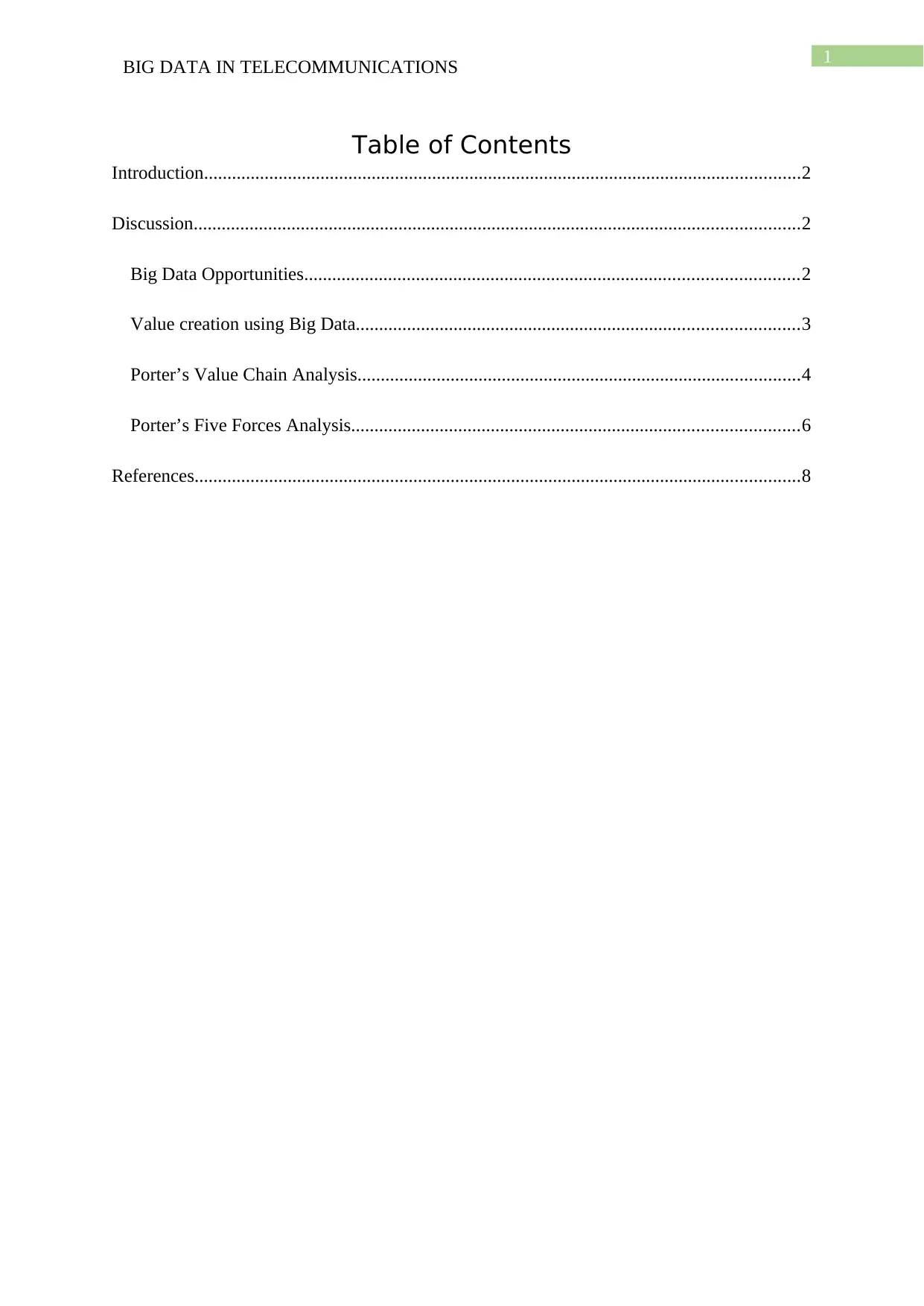
1
BIG DATA IN TELECOMMUNICATIONS
Table of Contents
Introduction................................................................................................................................2
Discussion..................................................................................................................................2
Big Data Opportunities..........................................................................................................2
Value creation using Big Data...............................................................................................3
Porter’s Value Chain Analysis...............................................................................................4
Porter’s Five Forces Analysis................................................................................................6
References..................................................................................................................................8
BIG DATA IN TELECOMMUNICATIONS
Table of Contents
Introduction................................................................................................................................2
Discussion..................................................................................................................................2
Big Data Opportunities..........................................................................................................2
Value creation using Big Data...............................................................................................3
Porter’s Value Chain Analysis...............................................................................................4
Porter’s Five Forces Analysis................................................................................................6
References..................................................................................................................................8
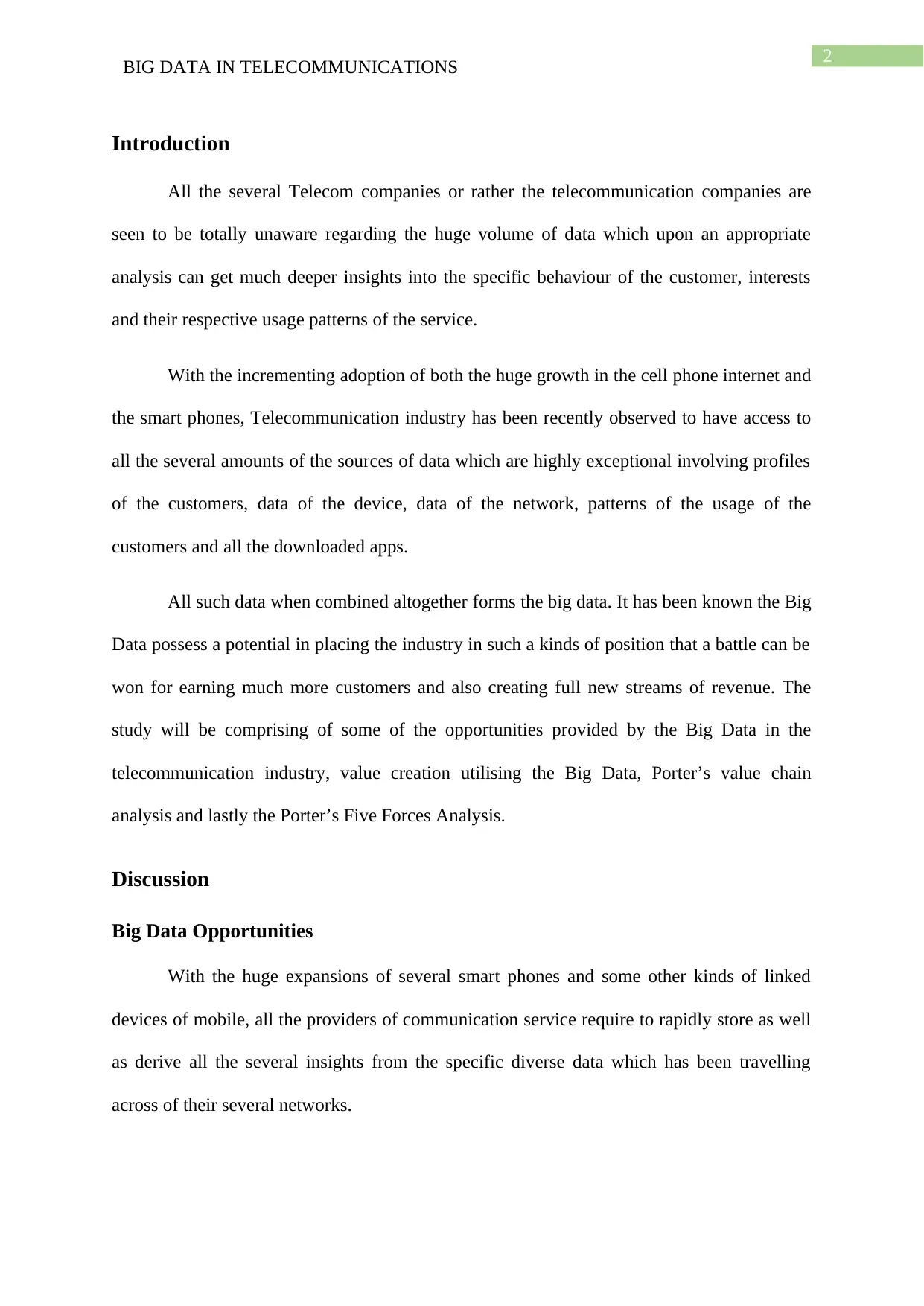
2
BIG DATA IN TELECOMMUNICATIONS
Introduction
All the several Telecom companies or rather the telecommunication companies are
seen to be totally unaware regarding the huge volume of data which upon an appropriate
analysis can get much deeper insights into the specific behaviour of the customer, interests
and their respective usage patterns of the service.
With the incrementing adoption of both the huge growth in the cell phone internet and
the smart phones, Telecommunication industry has been recently observed to have access to
all the several amounts of the sources of data which are highly exceptional involving profiles
of the customers, data of the device, data of the network, patterns of the usage of the
customers and all the downloaded apps.
All such data when combined altogether forms the big data. It has been known the Big
Data possess a potential in placing the industry in such a kinds of position that a battle can be
won for earning much more customers and also creating full new streams of revenue. The
study will be comprising of some of the opportunities provided by the Big Data in the
telecommunication industry, value creation utilising the Big Data, Porter’s value chain
analysis and lastly the Porter’s Five Forces Analysis.
Discussion
Big Data Opportunities
With the huge expansions of several smart phones and some other kinds of linked
devices of mobile, all the providers of communication service require to rapidly store as well
as derive all the several insights from the specific diverse data which has been travelling
across of their several networks.
BIG DATA IN TELECOMMUNICATIONS
Introduction
All the several Telecom companies or rather the telecommunication companies are
seen to be totally unaware regarding the huge volume of data which upon an appropriate
analysis can get much deeper insights into the specific behaviour of the customer, interests
and their respective usage patterns of the service.
With the incrementing adoption of both the huge growth in the cell phone internet and
the smart phones, Telecommunication industry has been recently observed to have access to
all the several amounts of the sources of data which are highly exceptional involving profiles
of the customers, data of the device, data of the network, patterns of the usage of the
customers and all the downloaded apps.
All such data when combined altogether forms the big data. It has been known the Big
Data possess a potential in placing the industry in such a kinds of position that a battle can be
won for earning much more customers and also creating full new streams of revenue. The
study will be comprising of some of the opportunities provided by the Big Data in the
telecommunication industry, value creation utilising the Big Data, Porter’s value chain
analysis and lastly the Porter’s Five Forces Analysis.
Discussion
Big Data Opportunities
With the huge expansions of several smart phones and some other kinds of linked
devices of mobile, all the providers of communication service require to rapidly store as well
as derive all the several insights from the specific diverse data which has been travelling
across of their several networks.
⊘ This is a preview!⊘
Do you want full access?
Subscribe today to unlock all pages.

Trusted by 1+ million students worldwide
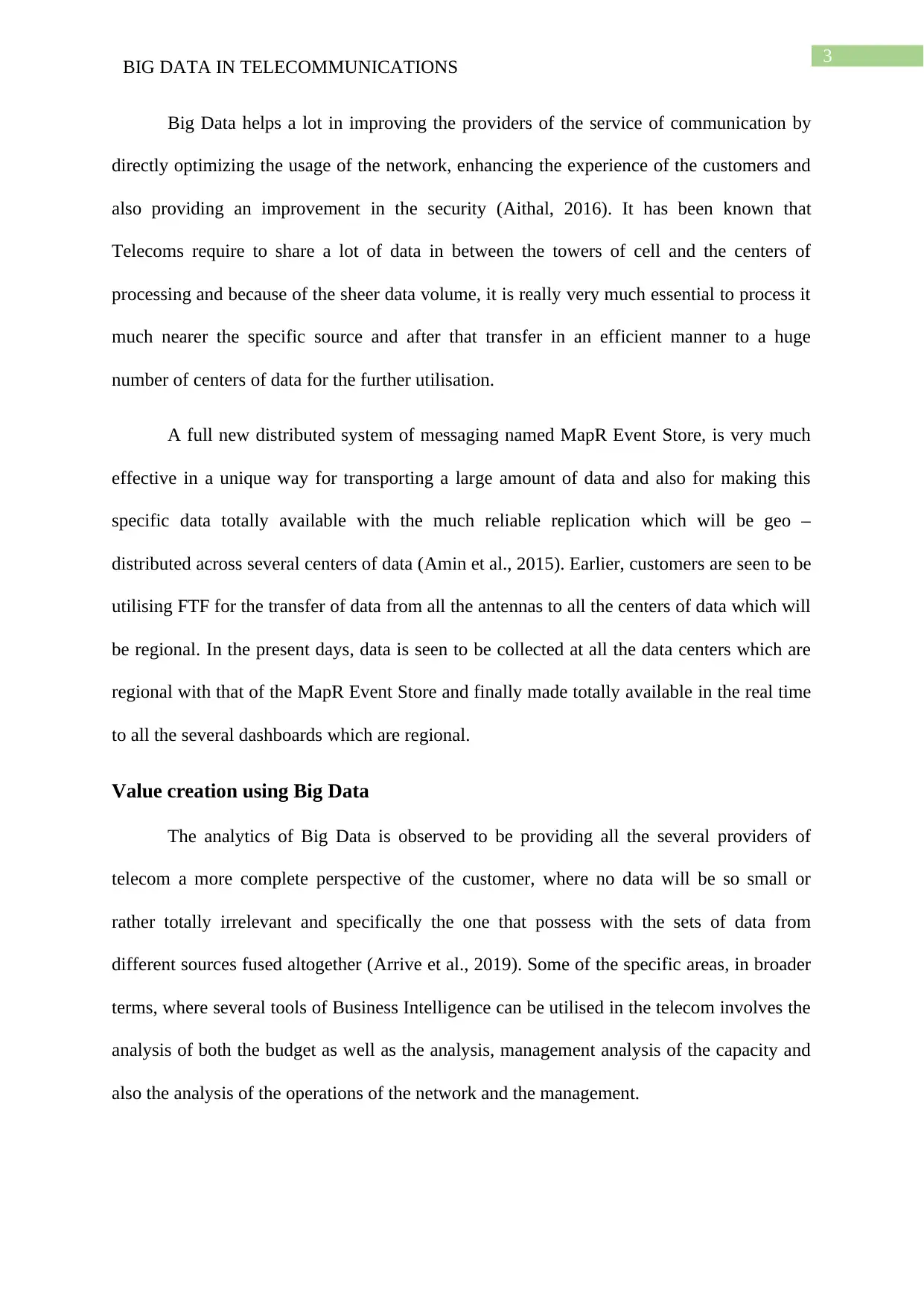
3
BIG DATA IN TELECOMMUNICATIONS
Big Data helps a lot in improving the providers of the service of communication by
directly optimizing the usage of the network, enhancing the experience of the customers and
also providing an improvement in the security (Aithal, 2016). It has been known that
Telecoms require to share a lot of data in between the towers of cell and the centers of
processing and because of the sheer data volume, it is really very much essential to process it
much nearer the specific source and after that transfer in an efficient manner to a huge
number of centers of data for the further utilisation.
A full new distributed system of messaging named MapR Event Store, is very much
effective in a unique way for transporting a large amount of data and also for making this
specific data totally available with the much reliable replication which will be geo –
distributed across several centers of data (Amin et al., 2015). Earlier, customers are seen to be
utilising FTF for the transfer of data from all the antennas to all the centers of data which will
be regional. In the present days, data is seen to be collected at all the data centers which are
regional with that of the MapR Event Store and finally made totally available in the real time
to all the several dashboards which are regional.
Value creation using Big Data
The analytics of Big Data is observed to be providing all the several providers of
telecom a more complete perspective of the customer, where no data will be so small or
rather totally irrelevant and specifically the one that possess with the sets of data from
different sources fused altogether (Arrive et al., 2019). Some of the specific areas, in broader
terms, where several tools of Business Intelligence can be utilised in the telecom involves the
analysis of both the budget as well as the analysis, management analysis of the capacity and
also the analysis of the operations of the network and the management.
BIG DATA IN TELECOMMUNICATIONS
Big Data helps a lot in improving the providers of the service of communication by
directly optimizing the usage of the network, enhancing the experience of the customers and
also providing an improvement in the security (Aithal, 2016). It has been known that
Telecoms require to share a lot of data in between the towers of cell and the centers of
processing and because of the sheer data volume, it is really very much essential to process it
much nearer the specific source and after that transfer in an efficient manner to a huge
number of centers of data for the further utilisation.
A full new distributed system of messaging named MapR Event Store, is very much
effective in a unique way for transporting a large amount of data and also for making this
specific data totally available with the much reliable replication which will be geo –
distributed across several centers of data (Amin et al., 2015). Earlier, customers are seen to be
utilising FTF for the transfer of data from all the antennas to all the centers of data which will
be regional. In the present days, data is seen to be collected at all the data centers which are
regional with that of the MapR Event Store and finally made totally available in the real time
to all the several dashboards which are regional.
Value creation using Big Data
The analytics of Big Data is observed to be providing all the several providers of
telecom a more complete perspective of the customer, where no data will be so small or
rather totally irrelevant and specifically the one that possess with the sets of data from
different sources fused altogether (Arrive et al., 2019). Some of the specific areas, in broader
terms, where several tools of Business Intelligence can be utilised in the telecom involves the
analysis of both the budget as well as the analysis, management analysis of the capacity and
also the analysis of the operations of the network and the management.
Paraphrase This Document
Need a fresh take? Get an instant paraphrase of this document with our AI Paraphraser
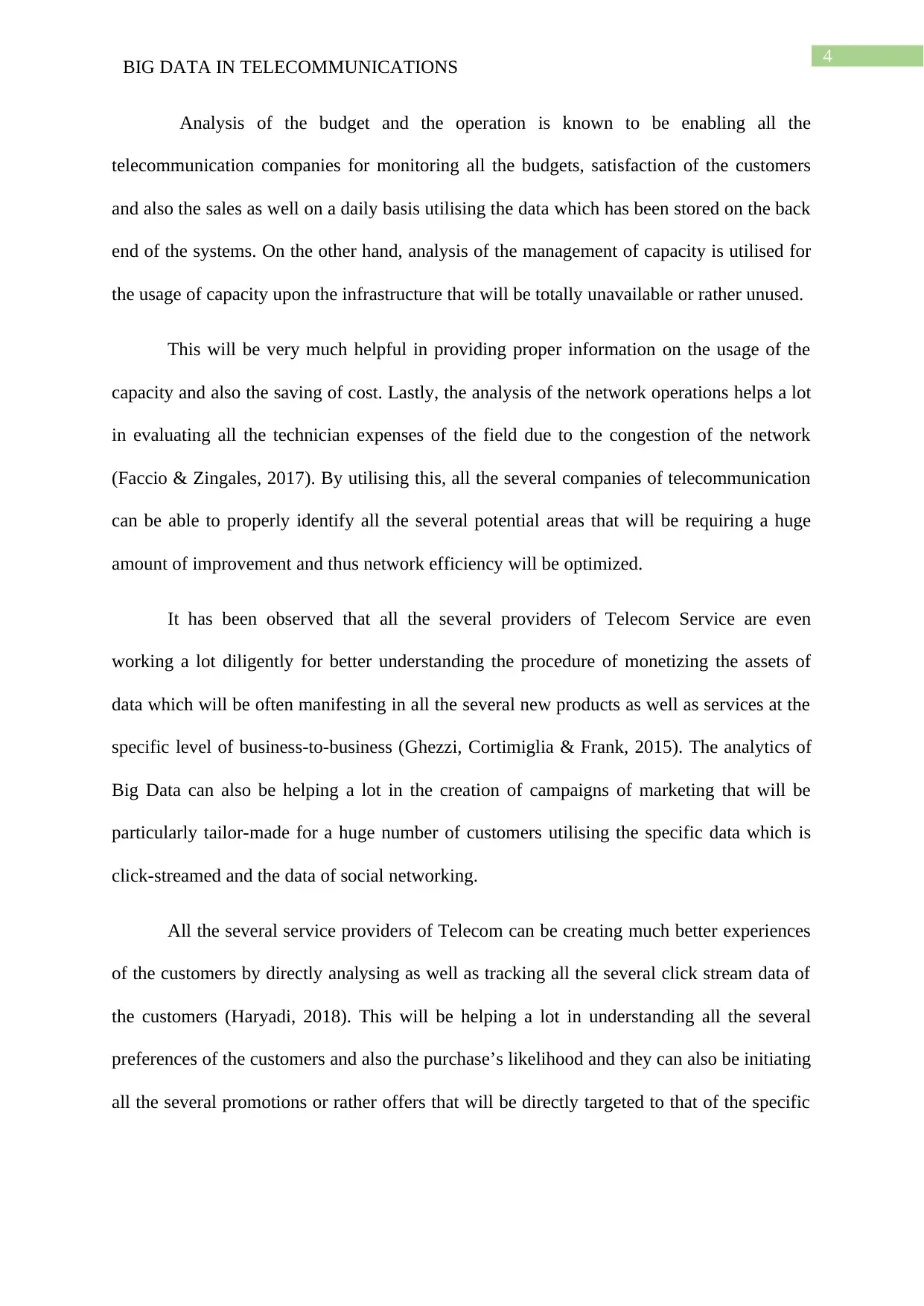
4
BIG DATA IN TELECOMMUNICATIONS
Analysis of the budget and the operation is known to be enabling all the
telecommunication companies for monitoring all the budgets, satisfaction of the customers
and also the sales as well on a daily basis utilising the data which has been stored on the back
end of the systems. On the other hand, analysis of the management of capacity is utilised for
the usage of capacity upon the infrastructure that will be totally unavailable or rather unused.
This will be very much helpful in providing proper information on the usage of the
capacity and also the saving of cost. Lastly, the analysis of the network operations helps a lot
in evaluating all the technician expenses of the field due to the congestion of the network
(Faccio & Zingales, 2017). By utilising this, all the several companies of telecommunication
can be able to properly identify all the several potential areas that will be requiring a huge
amount of improvement and thus network efficiency will be optimized.
It has been observed that all the several providers of Telecom Service are even
working a lot diligently for better understanding the procedure of monetizing the assets of
data which will be often manifesting in all the several new products as well as services at the
specific level of business-to-business (Ghezzi, Cortimiglia & Frank, 2015). The analytics of
Big Data can also be helping a lot in the creation of campaigns of marketing that will be
particularly tailor-made for a huge number of customers utilising the specific data which is
click-streamed and the data of social networking.
All the several service providers of Telecom can be creating much better experiences
of the customers by directly analysing as well as tracking all the several click stream data of
the customers (Haryadi, 2018). This will be helping a lot in understanding all the several
preferences of the customers and also the purchase’s likelihood and they can also be initiating
all the several promotions or rather offers that will be directly targeted to that of the specific
BIG DATA IN TELECOMMUNICATIONS
Analysis of the budget and the operation is known to be enabling all the
telecommunication companies for monitoring all the budgets, satisfaction of the customers
and also the sales as well on a daily basis utilising the data which has been stored on the back
end of the systems. On the other hand, analysis of the management of capacity is utilised for
the usage of capacity upon the infrastructure that will be totally unavailable or rather unused.
This will be very much helpful in providing proper information on the usage of the
capacity and also the saving of cost. Lastly, the analysis of the network operations helps a lot
in evaluating all the technician expenses of the field due to the congestion of the network
(Faccio & Zingales, 2017). By utilising this, all the several companies of telecommunication
can be able to properly identify all the several potential areas that will be requiring a huge
amount of improvement and thus network efficiency will be optimized.
It has been observed that all the several providers of Telecom Service are even
working a lot diligently for better understanding the procedure of monetizing the assets of
data which will be often manifesting in all the several new products as well as services at the
specific level of business-to-business (Ghezzi, Cortimiglia & Frank, 2015). The analytics of
Big Data can also be helping a lot in the creation of campaigns of marketing that will be
particularly tailor-made for a huge number of customers utilising the specific data which is
click-streamed and the data of social networking.
All the several service providers of Telecom can be creating much better experiences
of the customers by directly analysing as well as tracking all the several click stream data of
the customers (Haryadi, 2018). This will be helping a lot in understanding all the several
preferences of the customers and also the purchase’s likelihood and they can also be initiating
all the several promotions or rather offers that will be directly targeted to that of the specific
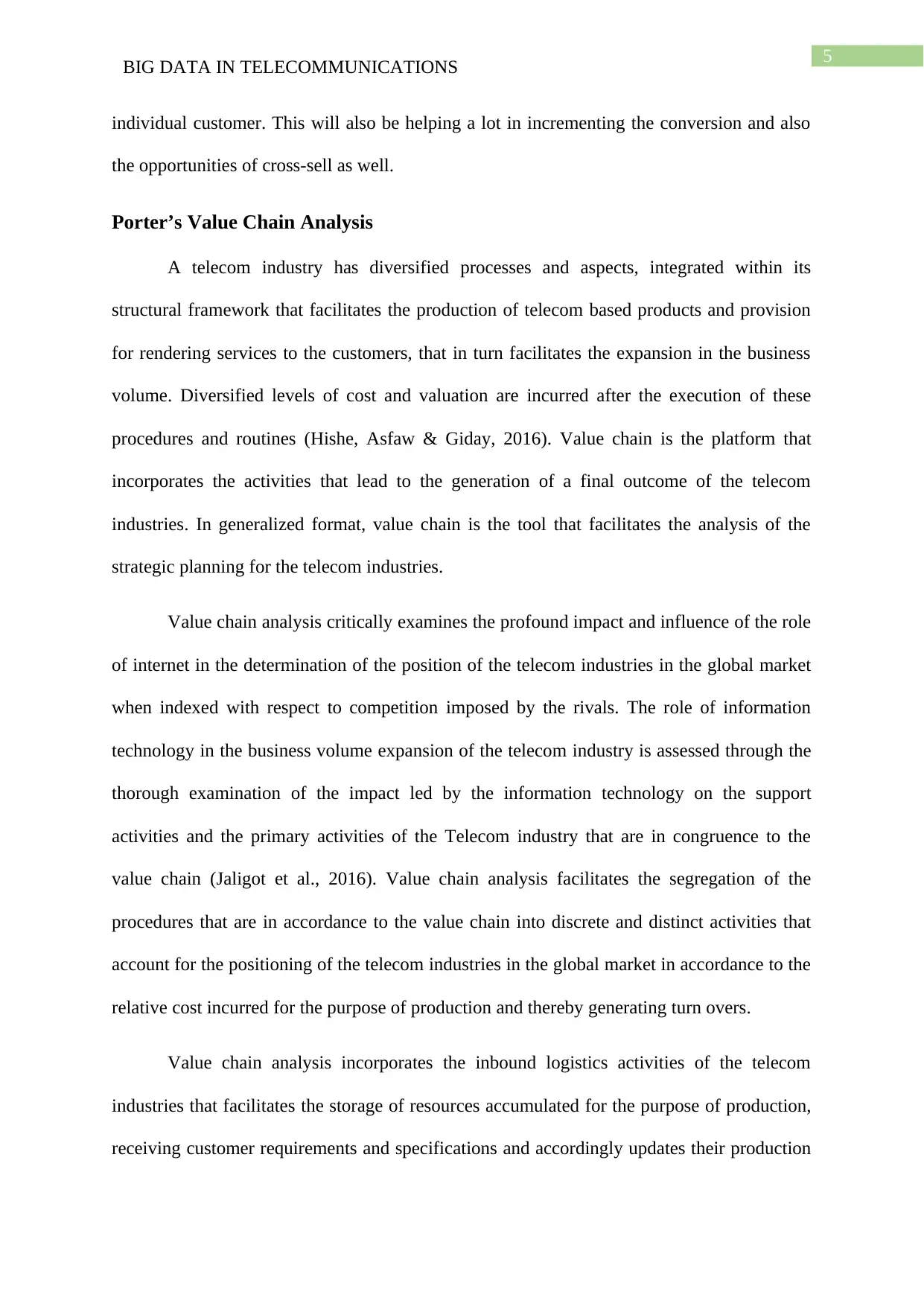
5
BIG DATA IN TELECOMMUNICATIONS
individual customer. This will also be helping a lot in incrementing the conversion and also
the opportunities of cross-sell as well.
Porter’s Value Chain Analysis
A telecom industry has diversified processes and aspects, integrated within its
structural framework that facilitates the production of telecom based products and provision
for rendering services to the customers, that in turn facilitates the expansion in the business
volume. Diversified levels of cost and valuation are incurred after the execution of these
procedures and routines (Hishe, Asfaw & Giday, 2016). Value chain is the platform that
incorporates the activities that lead to the generation of a final outcome of the telecom
industries. In generalized format, value chain is the tool that facilitates the analysis of the
strategic planning for the telecom industries.
Value chain analysis critically examines the profound impact and influence of the role
of internet in the determination of the position of the telecom industries in the global market
when indexed with respect to competition imposed by the rivals. The role of information
technology in the business volume expansion of the telecom industry is assessed through the
thorough examination of the impact led by the information technology on the support
activities and the primary activities of the Telecom industry that are in congruence to the
value chain (Jaligot et al., 2016). Value chain analysis facilitates the segregation of the
procedures that are in accordance to the value chain into discrete and distinct activities that
account for the positioning of the telecom industries in the global market in accordance to the
relative cost incurred for the purpose of production and thereby generating turn overs.
Value chain analysis incorporates the inbound logistics activities of the telecom
industries that facilitates the storage of resources accumulated for the purpose of production,
receiving customer requirements and specifications and accordingly updates their production
BIG DATA IN TELECOMMUNICATIONS
individual customer. This will also be helping a lot in incrementing the conversion and also
the opportunities of cross-sell as well.
Porter’s Value Chain Analysis
A telecom industry has diversified processes and aspects, integrated within its
structural framework that facilitates the production of telecom based products and provision
for rendering services to the customers, that in turn facilitates the expansion in the business
volume. Diversified levels of cost and valuation are incurred after the execution of these
procedures and routines (Hishe, Asfaw & Giday, 2016). Value chain is the platform that
incorporates the activities that lead to the generation of a final outcome of the telecom
industries. In generalized format, value chain is the tool that facilitates the analysis of the
strategic planning for the telecom industries.
Value chain analysis critically examines the profound impact and influence of the role
of internet in the determination of the position of the telecom industries in the global market
when indexed with respect to competition imposed by the rivals. The role of information
technology in the business volume expansion of the telecom industry is assessed through the
thorough examination of the impact led by the information technology on the support
activities and the primary activities of the Telecom industry that are in congruence to the
value chain (Jaligot et al., 2016). Value chain analysis facilitates the segregation of the
procedures that are in accordance to the value chain into discrete and distinct activities that
account for the positioning of the telecom industries in the global market in accordance to the
relative cost incurred for the purpose of production and thereby generating turn overs.
Value chain analysis incorporates the inbound logistics activities of the telecom
industries that facilitates the storage of resources accumulated for the purpose of production,
receiving customer requirements and specifications and accordingly updates their production
⊘ This is a preview!⊘
Do you want full access?
Subscribe today to unlock all pages.

Trusted by 1+ million students worldwide
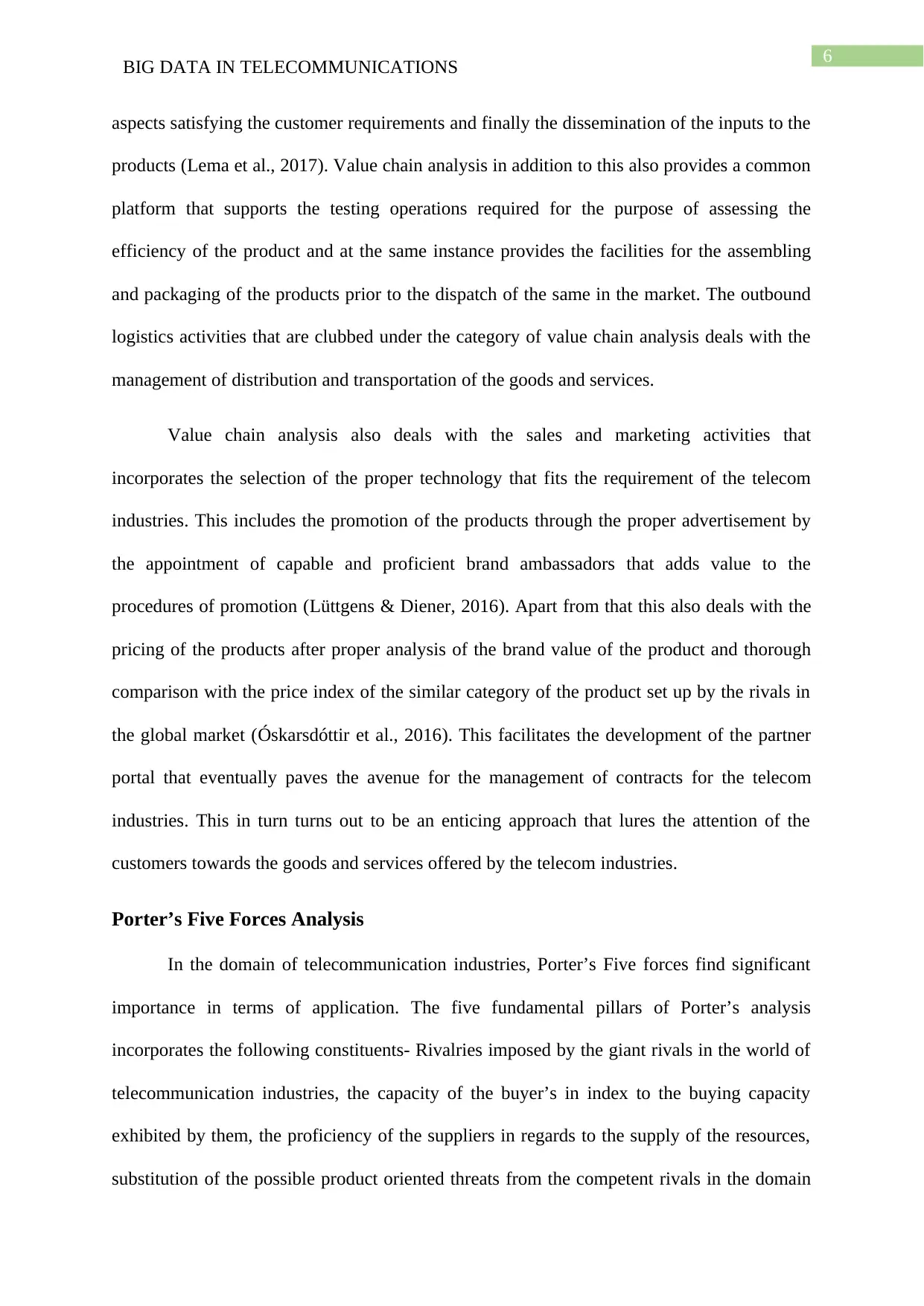
6
BIG DATA IN TELECOMMUNICATIONS
aspects satisfying the customer requirements and finally the dissemination of the inputs to the
products (Lema et al., 2017). Value chain analysis in addition to this also provides a common
platform that supports the testing operations required for the purpose of assessing the
efficiency of the product and at the same instance provides the facilities for the assembling
and packaging of the products prior to the dispatch of the same in the market. The outbound
logistics activities that are clubbed under the category of value chain analysis deals with the
management of distribution and transportation of the goods and services.
Value chain analysis also deals with the sales and marketing activities that
incorporates the selection of the proper technology that fits the requirement of the telecom
industries. This includes the promotion of the products through the proper advertisement by
the appointment of capable and proficient brand ambassadors that adds value to the
procedures of promotion (Lüttgens & Diener, 2016). Apart from that this also deals with the
pricing of the products after proper analysis of the brand value of the product and thorough
comparison with the price index of the similar category of the product set up by the rivals in
the global market (Óskarsdóttir et al., 2016). This facilitates the development of the partner
portal that eventually paves the avenue for the management of contracts for the telecom
industries. This in turn turns out to be an enticing approach that lures the attention of the
customers towards the goods and services offered by the telecom industries.
Porter’s Five Forces Analysis
In the domain of telecommunication industries, Porter’s Five forces find significant
importance in terms of application. The five fundamental pillars of Porter’s analysis
incorporates the following constituents- Rivalries imposed by the giant rivals in the world of
telecommunication industries, the capacity of the buyer’s in index to the buying capacity
exhibited by them, the proficiency of the suppliers in regards to the supply of the resources,
substitution of the possible product oriented threats from the competent rivals in the domain
BIG DATA IN TELECOMMUNICATIONS
aspects satisfying the customer requirements and finally the dissemination of the inputs to the
products (Lema et al., 2017). Value chain analysis in addition to this also provides a common
platform that supports the testing operations required for the purpose of assessing the
efficiency of the product and at the same instance provides the facilities for the assembling
and packaging of the products prior to the dispatch of the same in the market. The outbound
logistics activities that are clubbed under the category of value chain analysis deals with the
management of distribution and transportation of the goods and services.
Value chain analysis also deals with the sales and marketing activities that
incorporates the selection of the proper technology that fits the requirement of the telecom
industries. This includes the promotion of the products through the proper advertisement by
the appointment of capable and proficient brand ambassadors that adds value to the
procedures of promotion (Lüttgens & Diener, 2016). Apart from that this also deals with the
pricing of the products after proper analysis of the brand value of the product and thorough
comparison with the price index of the similar category of the product set up by the rivals in
the global market (Óskarsdóttir et al., 2016). This facilitates the development of the partner
portal that eventually paves the avenue for the management of contracts for the telecom
industries. This in turn turns out to be an enticing approach that lures the attention of the
customers towards the goods and services offered by the telecom industries.
Porter’s Five Forces Analysis
In the domain of telecommunication industries, Porter’s Five forces find significant
importance in terms of application. The five fundamental pillars of Porter’s analysis
incorporates the following constituents- Rivalries imposed by the giant rivals in the world of
telecommunication industries, the capacity of the buyer’s in index to the buying capacity
exhibited by them, the proficiency of the suppliers in regards to the supply of the resources,
substitution of the possible product oriented threats from the competent rivals in the domain
Paraphrase This Document
Need a fresh take? Get an instant paraphrase of this document with our AI Paraphraser
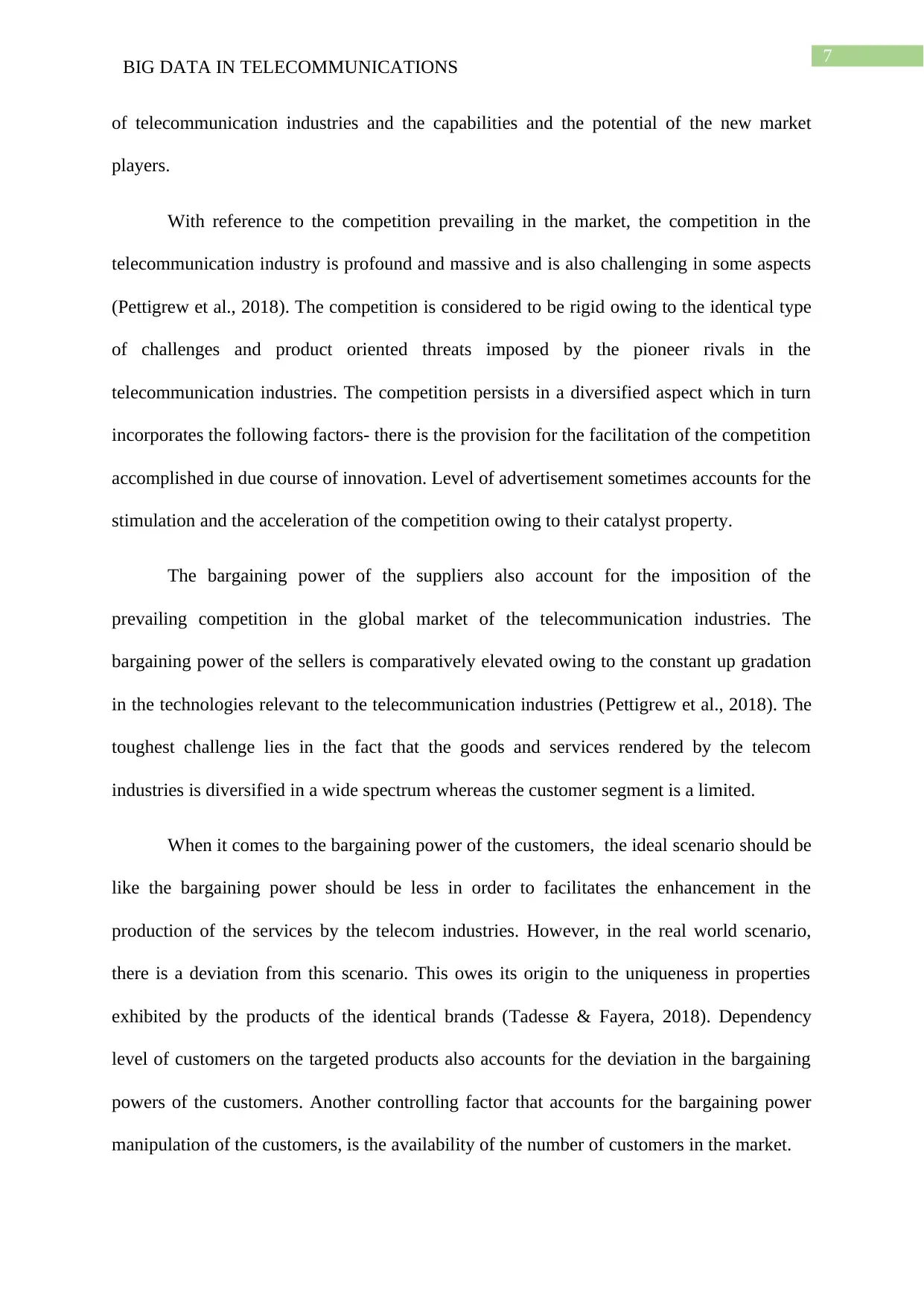
7
BIG DATA IN TELECOMMUNICATIONS
of telecommunication industries and the capabilities and the potential of the new market
players.
With reference to the competition prevailing in the market, the competition in the
telecommunication industry is profound and massive and is also challenging in some aspects
(Pettigrew et al., 2018). The competition is considered to be rigid owing to the identical type
of challenges and product oriented threats imposed by the pioneer rivals in the
telecommunication industries. The competition persists in a diversified aspect which in turn
incorporates the following factors- there is the provision for the facilitation of the competition
accomplished in due course of innovation. Level of advertisement sometimes accounts for the
stimulation and the acceleration of the competition owing to their catalyst property.
The bargaining power of the suppliers also account for the imposition of the
prevailing competition in the global market of the telecommunication industries. The
bargaining power of the sellers is comparatively elevated owing to the constant up gradation
in the technologies relevant to the telecommunication industries (Pettigrew et al., 2018). The
toughest challenge lies in the fact that the goods and services rendered by the telecom
industries is diversified in a wide spectrum whereas the customer segment is a limited.
When it comes to the bargaining power of the customers, the ideal scenario should be
like the bargaining power should be less in order to facilitates the enhancement in the
production of the services by the telecom industries. However, in the real world scenario,
there is a deviation from this scenario. This owes its origin to the uniqueness in properties
exhibited by the products of the identical brands (Tadesse & Fayera, 2018). Dependency
level of customers on the targeted products also accounts for the deviation in the bargaining
powers of the customers. Another controlling factor that accounts for the bargaining power
manipulation of the customers, is the availability of the number of customers in the market.
BIG DATA IN TELECOMMUNICATIONS
of telecommunication industries and the capabilities and the potential of the new market
players.
With reference to the competition prevailing in the market, the competition in the
telecommunication industry is profound and massive and is also challenging in some aspects
(Pettigrew et al., 2018). The competition is considered to be rigid owing to the identical type
of challenges and product oriented threats imposed by the pioneer rivals in the
telecommunication industries. The competition persists in a diversified aspect which in turn
incorporates the following factors- there is the provision for the facilitation of the competition
accomplished in due course of innovation. Level of advertisement sometimes accounts for the
stimulation and the acceleration of the competition owing to their catalyst property.
The bargaining power of the suppliers also account for the imposition of the
prevailing competition in the global market of the telecommunication industries. The
bargaining power of the sellers is comparatively elevated owing to the constant up gradation
in the technologies relevant to the telecommunication industries (Pettigrew et al., 2018). The
toughest challenge lies in the fact that the goods and services rendered by the telecom
industries is diversified in a wide spectrum whereas the customer segment is a limited.
When it comes to the bargaining power of the customers, the ideal scenario should be
like the bargaining power should be less in order to facilitates the enhancement in the
production of the services by the telecom industries. However, in the real world scenario,
there is a deviation from this scenario. This owes its origin to the uniqueness in properties
exhibited by the products of the identical brands (Tadesse & Fayera, 2018). Dependency
level of customers on the targeted products also accounts for the deviation in the bargaining
powers of the customers. Another controlling factor that accounts for the bargaining power
manipulation of the customers, is the availability of the number of customers in the market.
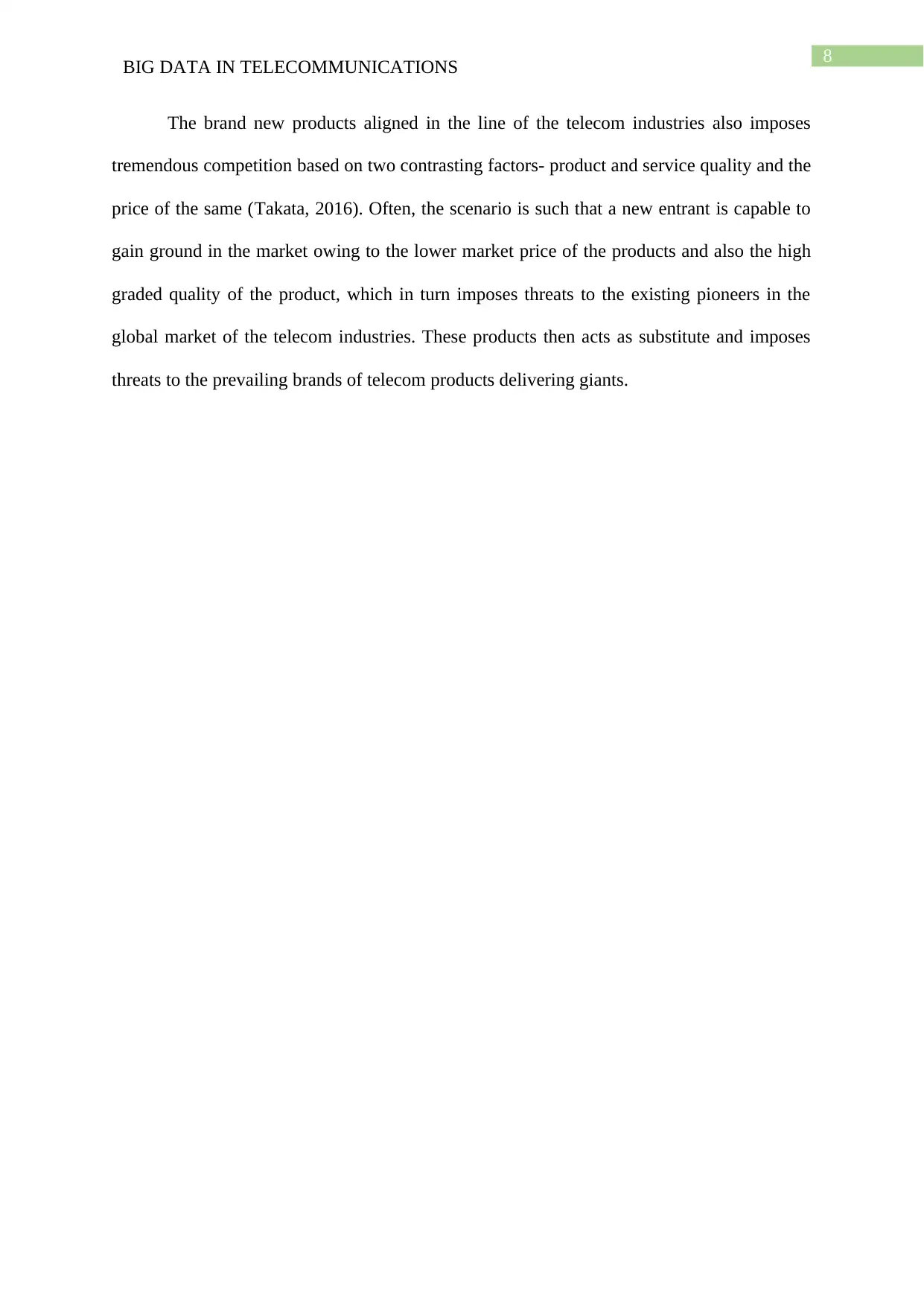
8
BIG DATA IN TELECOMMUNICATIONS
The brand new products aligned in the line of the telecom industries also imposes
tremendous competition based on two contrasting factors- product and service quality and the
price of the same (Takata, 2016). Often, the scenario is such that a new entrant is capable to
gain ground in the market owing to the lower market price of the products and also the high
graded quality of the product, which in turn imposes threats to the existing pioneers in the
global market of the telecom industries. These products then acts as substitute and imposes
threats to the prevailing brands of telecom products delivering giants.
BIG DATA IN TELECOMMUNICATIONS
The brand new products aligned in the line of the telecom industries also imposes
tremendous competition based on two contrasting factors- product and service quality and the
price of the same (Takata, 2016). Often, the scenario is such that a new entrant is capable to
gain ground in the market owing to the lower market price of the products and also the high
graded quality of the product, which in turn imposes threats to the existing pioneers in the
global market of the telecom industries. These products then acts as substitute and imposes
threats to the prevailing brands of telecom products delivering giants.
⊘ This is a preview!⊘
Do you want full access?
Subscribe today to unlock all pages.

Trusted by 1+ million students worldwide
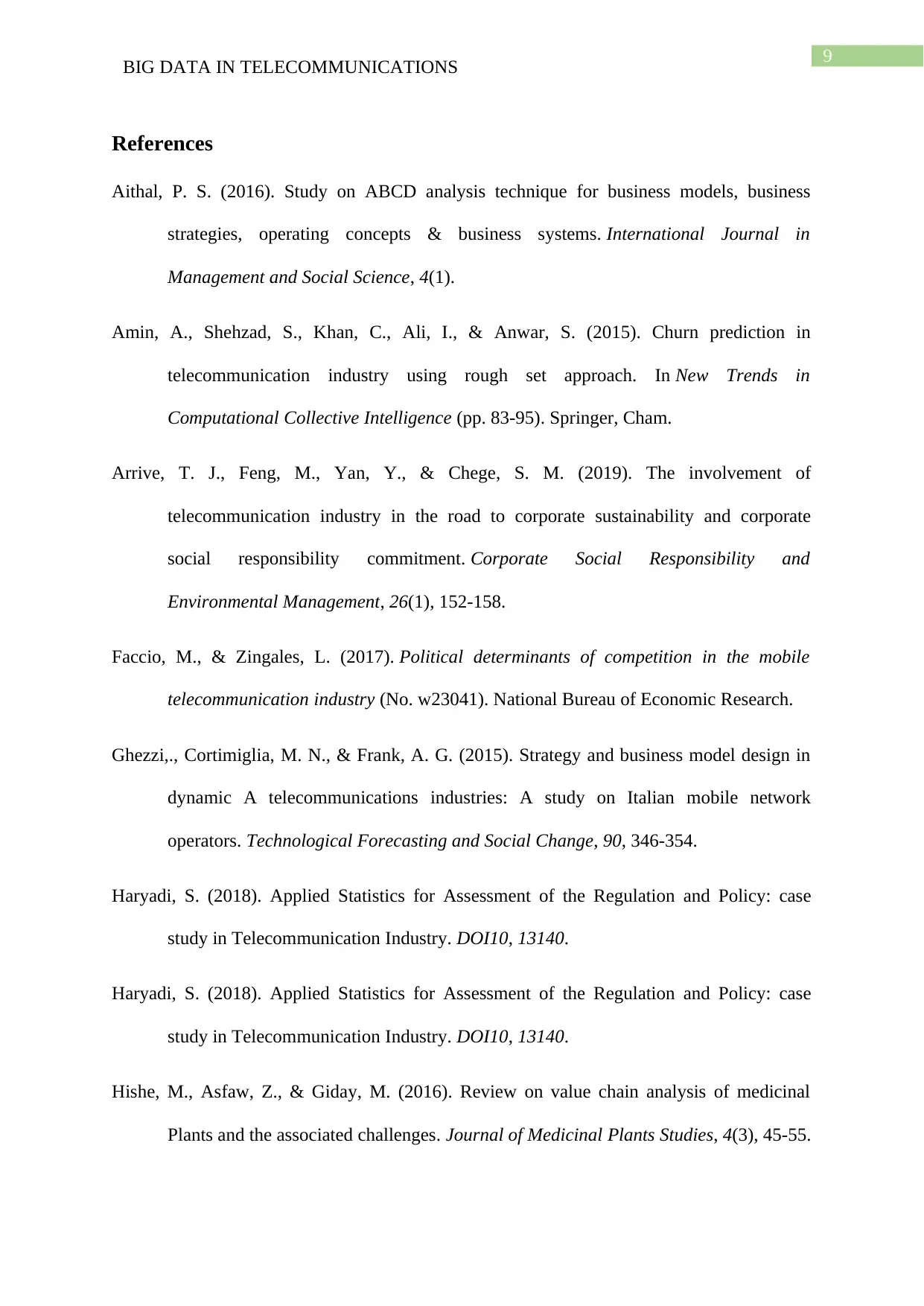
9
BIG DATA IN TELECOMMUNICATIONS
References
Aithal, P. S. (2016). Study on ABCD analysis technique for business models, business
strategies, operating concepts & business systems. International Journal in
Management and Social Science, 4(1).
Amin, A., Shehzad, S., Khan, C., Ali, I., & Anwar, S. (2015). Churn prediction in
telecommunication industry using rough set approach. In New Trends in
Computational Collective Intelligence (pp. 83-95). Springer, Cham.
Arrive, T. J., Feng, M., Yan, Y., & Chege, S. M. (2019). The involvement of
telecommunication industry in the road to corporate sustainability and corporate
social responsibility commitment. Corporate Social Responsibility and
Environmental Management, 26(1), 152-158.
Faccio, M., & Zingales, L. (2017). Political determinants of competition in the mobile
telecommunication industry (No. w23041). National Bureau of Economic Research.
Ghezzi,., Cortimiglia, M. N., & Frank, A. G. (2015). Strategy and business model design in
dynamic A telecommunications industries: A study on Italian mobile network
operators. Technological Forecasting and Social Change, 90, 346-354.
Haryadi, S. (2018). Applied Statistics for Assessment of the Regulation and Policy: case
study in Telecommunication Industry. DOI10, 13140.
Haryadi, S. (2018). Applied Statistics for Assessment of the Regulation and Policy: case
study in Telecommunication Industry. DOI10, 13140.
Hishe, M., Asfaw, Z., & Giday, M. (2016). Review on value chain analysis of medicinal
Plants and the associated challenges. Journal of Medicinal Plants Studies, 4(3), 45-55.
BIG DATA IN TELECOMMUNICATIONS
References
Aithal, P. S. (2016). Study on ABCD analysis technique for business models, business
strategies, operating concepts & business systems. International Journal in
Management and Social Science, 4(1).
Amin, A., Shehzad, S., Khan, C., Ali, I., & Anwar, S. (2015). Churn prediction in
telecommunication industry using rough set approach. In New Trends in
Computational Collective Intelligence (pp. 83-95). Springer, Cham.
Arrive, T. J., Feng, M., Yan, Y., & Chege, S. M. (2019). The involvement of
telecommunication industry in the road to corporate sustainability and corporate
social responsibility commitment. Corporate Social Responsibility and
Environmental Management, 26(1), 152-158.
Faccio, M., & Zingales, L. (2017). Political determinants of competition in the mobile
telecommunication industry (No. w23041). National Bureau of Economic Research.
Ghezzi,., Cortimiglia, M. N., & Frank, A. G. (2015). Strategy and business model design in
dynamic A telecommunications industries: A study on Italian mobile network
operators. Technological Forecasting and Social Change, 90, 346-354.
Haryadi, S. (2018). Applied Statistics for Assessment of the Regulation and Policy: case
study in Telecommunication Industry. DOI10, 13140.
Haryadi, S. (2018). Applied Statistics for Assessment of the Regulation and Policy: case
study in Telecommunication Industry. DOI10, 13140.
Hishe, M., Asfaw, Z., & Giday, M. (2016). Review on value chain analysis of medicinal
Plants and the associated challenges. Journal of Medicinal Plants Studies, 4(3), 45-55.
Paraphrase This Document
Need a fresh take? Get an instant paraphrase of this document with our AI Paraphraser
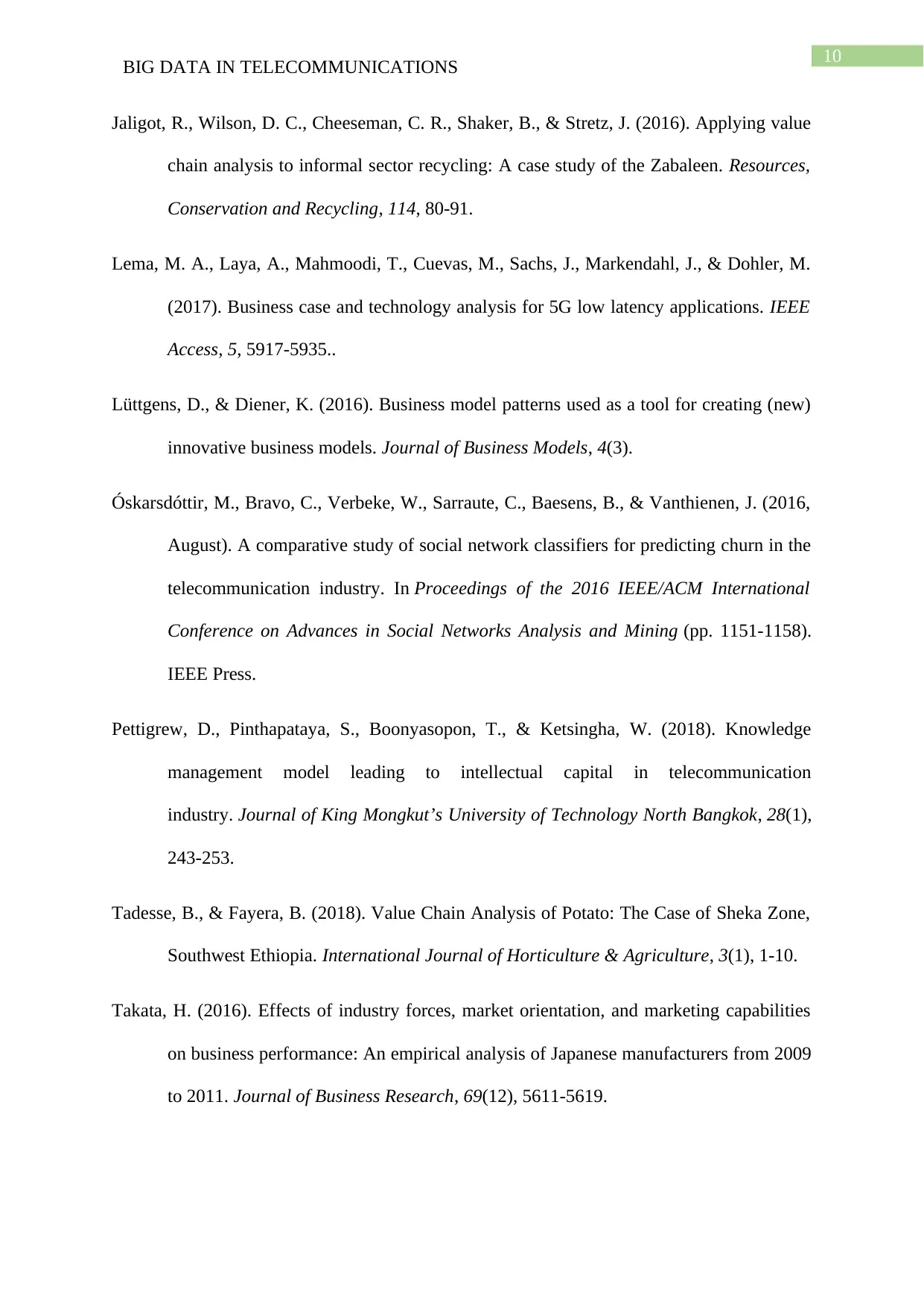
10
BIG DATA IN TELECOMMUNICATIONS
Jaligot, R., Wilson, D. C., Cheeseman, C. R., Shaker, B., & Stretz, J. (2016). Applying value
chain analysis to informal sector recycling: A case study of the Zabaleen. Resources,
Conservation and Recycling, 114, 80-91.
Lema, M. A., Laya, A., Mahmoodi, T., Cuevas, M., Sachs, J., Markendahl, J., & Dohler, M.
(2017). Business case and technology analysis for 5G low latency applications. IEEE
Access, 5, 5917-5935..
Lüttgens, D., & Diener, K. (2016). Business model patterns used as a tool for creating (new)
innovative business models. Journal of Business Models, 4(3).
Óskarsdóttir, M., Bravo, C., Verbeke, W., Sarraute, C., Baesens, B., & Vanthienen, J. (2016,
August). A comparative study of social network classifiers for predicting churn in the
telecommunication industry. In Proceedings of the 2016 IEEE/ACM International
Conference on Advances in Social Networks Analysis and Mining (pp. 1151-1158).
IEEE Press.
Pettigrew, D., Pinthapataya, S., Boonyasopon, T., & Ketsingha, W. (2018). Knowledge
management model leading to intellectual capital in telecommunication
industry. Journal of King Mongkut’s University of Technology North Bangkok, 28(1),
243-253.
Tadesse, B., & Fayera, B. (2018). Value Chain Analysis of Potato: The Case of Sheka Zone,
Southwest Ethiopia. International Journal of Horticulture & Agriculture, 3(1), 1-10.
Takata, H. (2016). Effects of industry forces, market orientation, and marketing capabilities
on business performance: An empirical analysis of Japanese manufacturers from 2009
to 2011. Journal of Business Research, 69(12), 5611-5619.
BIG DATA IN TELECOMMUNICATIONS
Jaligot, R., Wilson, D. C., Cheeseman, C. R., Shaker, B., & Stretz, J. (2016). Applying value
chain analysis to informal sector recycling: A case study of the Zabaleen. Resources,
Conservation and Recycling, 114, 80-91.
Lema, M. A., Laya, A., Mahmoodi, T., Cuevas, M., Sachs, J., Markendahl, J., & Dohler, M.
(2017). Business case and technology analysis for 5G low latency applications. IEEE
Access, 5, 5917-5935..
Lüttgens, D., & Diener, K. (2016). Business model patterns used as a tool for creating (new)
innovative business models. Journal of Business Models, 4(3).
Óskarsdóttir, M., Bravo, C., Verbeke, W., Sarraute, C., Baesens, B., & Vanthienen, J. (2016,
August). A comparative study of social network classifiers for predicting churn in the
telecommunication industry. In Proceedings of the 2016 IEEE/ACM International
Conference on Advances in Social Networks Analysis and Mining (pp. 1151-1158).
IEEE Press.
Pettigrew, D., Pinthapataya, S., Boonyasopon, T., & Ketsingha, W. (2018). Knowledge
management model leading to intellectual capital in telecommunication
industry. Journal of King Mongkut’s University of Technology North Bangkok, 28(1),
243-253.
Tadesse, B., & Fayera, B. (2018). Value Chain Analysis of Potato: The Case of Sheka Zone,
Southwest Ethiopia. International Journal of Horticulture & Agriculture, 3(1), 1-10.
Takata, H. (2016). Effects of industry forces, market orientation, and marketing capabilities
on business performance: An empirical analysis of Japanese manufacturers from 2009
to 2011. Journal of Business Research, 69(12), 5611-5619.

11
BIG DATA IN TELECOMMUNICATIONS
Toro-Jarrín, M. A., Ponce-Jaramillo, I. E., & Güemes-Castorena, D. (2016). Methodology for
the of building process integration of Business Model Canvas and Technological
Roadmap. Technological Forecasting and Social Change, 110, 213-225.
White, D. J., Hubacek, K., Feng, K., Sun, L., & Meng, B. (2018). The Water-Energy-Food
Nexus in East Asia: A tele-connected value chain analysis using inter-regional input-
output analysis. Applied Energy, 210, 550-567.
BIG DATA IN TELECOMMUNICATIONS
Toro-Jarrín, M. A., Ponce-Jaramillo, I. E., & Güemes-Castorena, D. (2016). Methodology for
the of building process integration of Business Model Canvas and Technological
Roadmap. Technological Forecasting and Social Change, 110, 213-225.
White, D. J., Hubacek, K., Feng, K., Sun, L., & Meng, B. (2018). The Water-Energy-Food
Nexus in East Asia: A tele-connected value chain analysis using inter-regional input-
output analysis. Applied Energy, 210, 550-567.
⊘ This is a preview!⊘
Do you want full access?
Subscribe today to unlock all pages.

Trusted by 1+ million students worldwide
1 out of 12
Related Documents
Your All-in-One AI-Powered Toolkit for Academic Success.
+13062052269
info@desklib.com
Available 24*7 on WhatsApp / Email
![[object Object]](/_next/static/media/star-bottom.7253800d.svg)
Unlock your academic potential
Copyright © 2020–2025 A2Z Services. All Rights Reserved. Developed and managed by ZUCOL.





